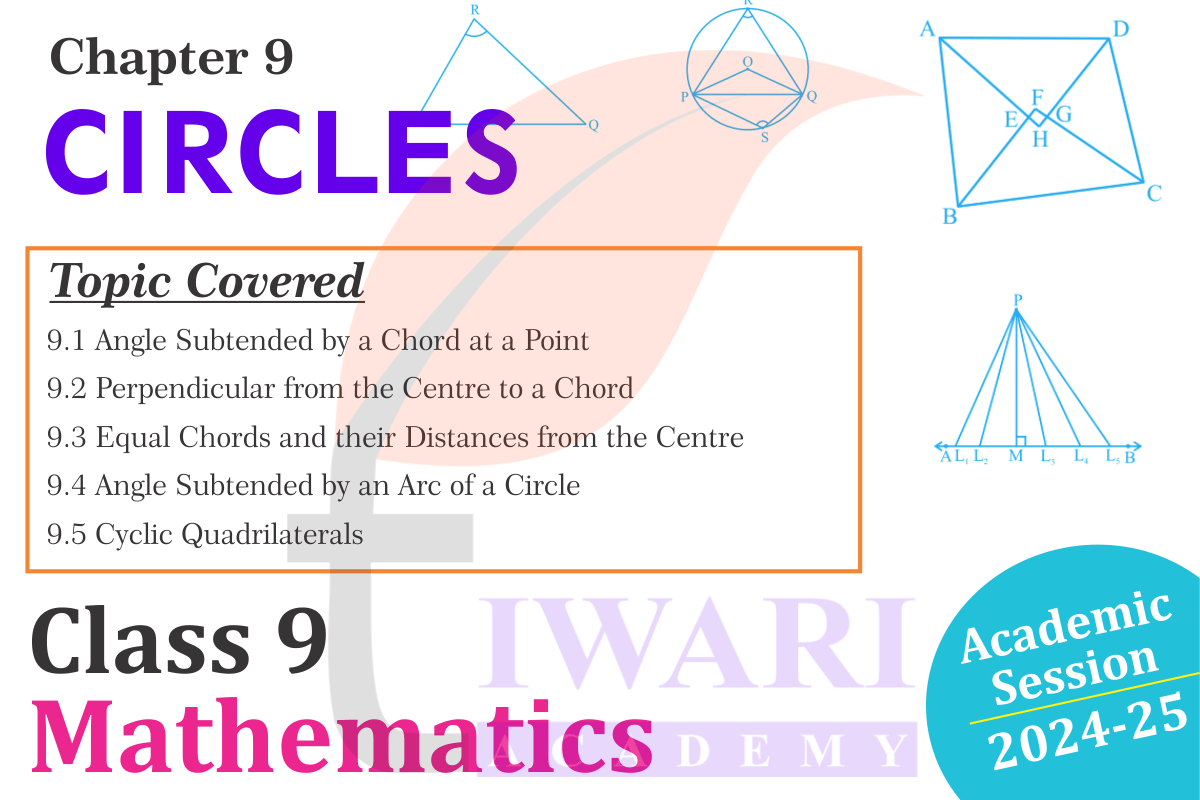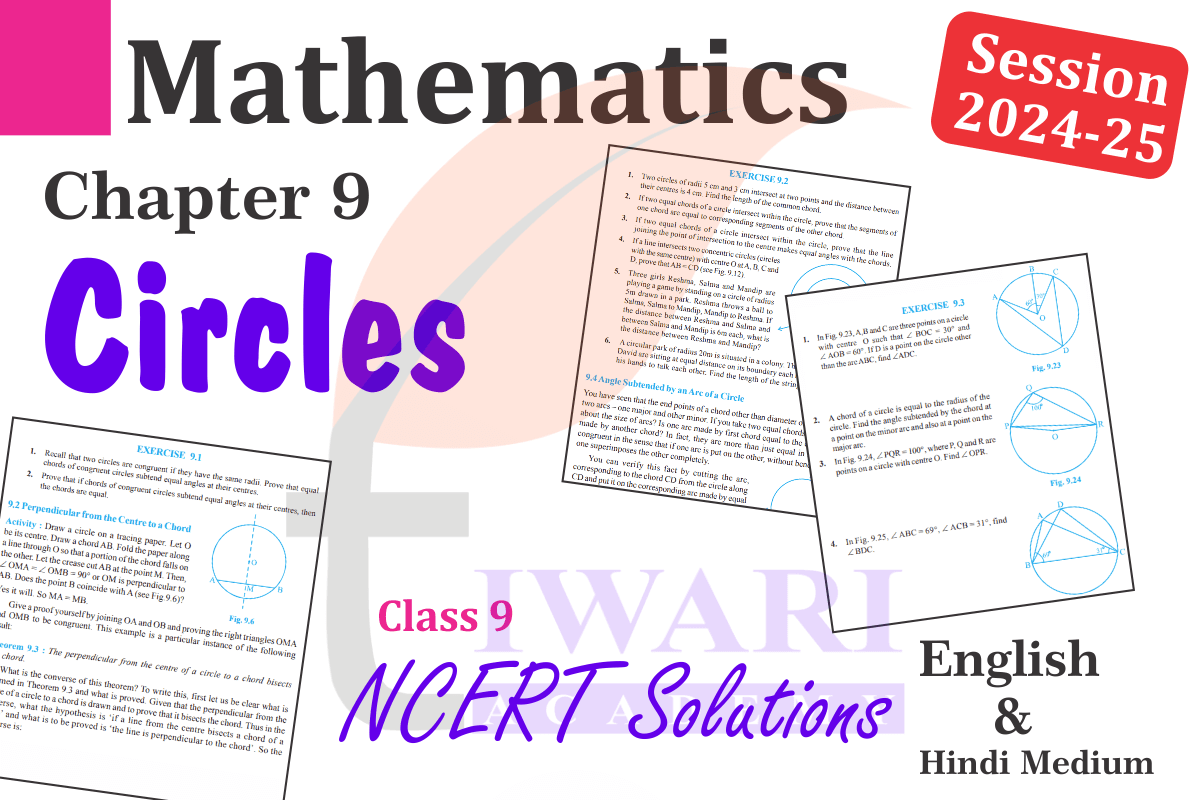NCERT Solutions for Class 9 Maths Chapter 9 Circles in English and Hindi Medium updated for new session 2024-25. According to revised syllabus and new NCERT books for CBSE 2024-25, there are only three exercises in chapter 9 of 9th Maths.
Class 9 Maths Chapter 9 Solutions for CBSE Board
Class 9 Maths Exercise 9.1 in English
Class 9 Maths Exercise 9.2 in English
Class 9 Maths Exercise 9.3 in English
Class 9 Maths Chapter 9 Solutions for State Boards
Class 9 Maths Chapter 9 Exercise 9.1
Class 9 Maths Chapter 9 Exercise 9.2
Class 9 Maths Chapter 9 Exercise 9.3
Class 9 Maths Chapter 9 Exercise 9.4
Tiwari Academy’s solutions can serve as valuable revision tools. Students can revisit specific topics or problem-solving techniques when preparing for exams, helping them consolidate their knowledge.
Class 9 Maths Chapter 9 Solutions in Hindi Medium
Class 9 Maths Exercise 9.1 in Hindi
Class 9 Maths Exercise 9.2 in Hindi
Class 9 Maths Exercise 9.3 in Hindi
NCERT Solutions for Class 9 Maths Chapter 9
| Class: 9 | Mathematics |
| Chapter 9: | Circles |
| Number of Exercises: | 3 (Three) |
| Content: | NCERT Exercises Solution |
| Mode of Content: | Images, PDF, Text and Videos Format |
| Academic Session: | CBSE 2024-25 |
| Medium: | Hindi and English Medium |

UP Board NCERT Solutions for Class 9 Maths Chapter 9 Prashnavali 9.1, Prashnavali 9.2 and Prashnavali 9.3 in Hindi Medium to study online or download in PDF format free for the new CBSE session 2024-25. All the solutions for 9th Maths are updated for the new session based on NCERT (https://ncert.nic.in/) Books 2024-25. Most of the state board like UP Board, MP Board, Jammu and Kashmir, Uttarakhand, etc., are now following NCERT Textbooks for their academic session. So, these solutions are applicable for all these boards also. All the questions are explained well using the theorems of circles and giving proper examples. In few questions some axioms of circles are also used as theorems.
Class 9 Maths Study Material for Chapter 9
Class 9 Maths Chapter 9 Practice Questions with Solution
What do understand by a circle?
Circle: A circle is the collection of all points in a plane, which are at a fixed distance from a fixed point in the plane.
What are the components of a circle?
1. Diameter: It is the longest chord of the circle.
2. Circumference: The length of complete circle is called its circumference.
3. Arc: A piece of circle between two point is called arc.
4. Segment: The region between a chord and either of its arcs is called a segment of circular region.
Properties related to CIRCLE
1. Equal chords of a circle subtend equal angles at the centre.
2. If the angles subtended by two chords of a circle at the centre are equal, the chords are also equal.
3. The perpendicular from the centre of a circle to a chord bisects the chord.
4. The line drawn through the centre of a circle to bisect a chord is perpendicular to the chord.
5. There is one and only one circle passing through three non-collinear points.

NCERT Solutions 2024-25 and CBSE Offline Apps of other subjects are also available free to use or download. Solutions are prepared for CBSE and UP Board students appearing in 2024-25 CBSE Exams and following the updated NCERT Books. UP Board NCERT Solutions for Class 9 Maths Chapter 9 Circles all Exercises are given below.
Important Questions on 9th Maths Chapter 9
If diagonals of a cyclic quadrilateral are diameters of the circle through the vertices of the quadrilateral, prove that it is a rectangle.
AC is diameter of circle. Hence, ∠ADC = 90° and ∠ABC = 90° … (1) [∵ Angle in a semicircle is a right angle.] Similarly, BD is diameter of circle. Hence, ∠BAD = 90° and ∠BCD = 90° … (2) [∵ Angle in a semicircle is a right angle.] From the equation (1) and (2), ∠ADC =∠ABC = ∠BAD = ∠BCD = 90° Hence, ABCD is a rectangle.
Fill in the blank: The centre of a circle lies in _____________ of the circle.
The centre of a circle lies in interior of the circle.
A circle has only finite number of equal chords. True or False?
False. Because, there are infinite number of equal chords in a circle.
Sector is the region between the chord and its corresponding arc. Is it true or false?
Sector is the region between the chord and its corresponding arc. False. Because, between chord and arc a segment is formed. Sector is the region which is formed between radii and arc.
ABC and ADC are two right triangles with common hypotenuse AC. Prove that ∠CAD = ∠CBD.
Given: Triangle ABC and ADC are two right triangle on common base AC.
To prove: ∠CAD = ∠CBD.
Proof: Triangle ABC and ADC are on common base BC and ∠BAC = ∠BDC.
Hence, points A, B, C and D lie on the same circle.
[∵ If a line segment joining two points subtends equal angles at two other points lying on the same side of the line containing the line segment, the four points lie on a circle.]
Therefore, ∠CAD = ∠CBD [∵ Angles in the same segments are equal]
Important Theorems on Circles Class 9 Mathematics Chapter 9
1. Equal chords of a circle are equidistant from the centre and cords equidistant from the centre of a circle are equal.
2. If two arcs of a circle are congruent, then their corresponding chords are equal and conversely if two chords of a circle are equal, then their corresponding arcs are congruent.
3. Congruent arcs of a circle subtend equal angles at the centre.
4. The angle subtended by an arc at the centre is double the angle subtended by it at any point on the remaining part of the circle.
5. Angles in the same segment of a circle are equal.
6. Angle in a semi-circle is a right angle.
7. The sum of either pair of opposite angles of a cyclic quadrilateral is 180 and if the sum of a pair of opposite angles of a quadrilateral is 180, then the quadrilateral is cyclic.


